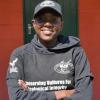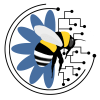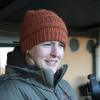With new technologies revolutionizing data collection, wildlife researchers are becoming increasingly able to collect data at much higher volumes than ever before. Now we are facing the challenges of putting this information to use, bringing the science of big data into the conservation arena. With the help of machine learning tools, this area holds immense potential for conservation practices. The applications range from online trafficking alerts to species-specific early warning systems to efficient movement and biodiversity monitoring and beyond.
However, the process of building effective machine learning tools depends upon large amounts of standardized training data, and conservationists currently lack an established system for standardization. How to best develop such a system and incentivize data sharing are questions at the forefront of this work. There are currently multiple AI-based conservation initiatives, including Wildlife Insights and WildBook, that are pioneering applications on this front.
This group is the perfect place to ask all your AI-related questions, no matter your skill level or previous familiarity! You'll find resources, meet other members with similar questions and experts who can answer them, and engage in exciting collaborative opportunities together.
Just getting started with AI in conservation? Check out our introduction tutorial, How Do I Train My First Machine Learning Model? with Daniel Situnayake, and our Virtual Meetup on Big Data. If you're coming from the more technical side of AI/ML, Sara Beery runs an AI for Conservation slack channel that might be of interest. Message her for an invite.
Header Image: Dr Claire Burke / @CBurkeSci

Explore the Basics: AI
Understanding the possibilities for incorporating new technology into your work can feel overwhelming. With so many tools available, so many resources to keep up with, and so many innovative projects happening around the world and in our community, it's easy to lose sight of how and why these new technologies matter, and how they can be practically applied to your projects.
Machine learning has huge potential in conservation tech, and its applications are growing every day! But the tradeoff of that potential is a big learning curve - or so it seems to those starting out with this powerful tool!
To help you explore the potential of AI (and prepare for some of our upcoming AI-themed events!), we've compiled simple, key resources, conversations, and videos to highlight the possibilities:
Three Resources for Beginners:
- Everything I know about Machine Learning and Camera Traps, Dan Morris | Resource library, camera traps, machine learning
- Using Computer Vision to Protect Endangered Species, Kasim Rafiq | Machine learning, data analysis, big cats
- Resource: WildID | WildID
Three Forum Threads for Beginners:
- I made an open-source tool to help you sort camera trap images | Petar Gyurov, Camera Traps
- Batch / Automated Cloud Processing | Chris Nicolas, Acoustic Monitoring
- Looking for help with camera trapping for Jaguars: Software for species ID and database building | Carmina Gutierrez, AI for Conservation
Three Tutorials for Beginners:
- How do I get started using machine learning for my camera traps? | Sara Beery, Tech Tutors
- How do I train my first machine learning model? | Daniel Situnayake, Tech Tutors
- Big Data in Conservation | Dave Thau, Dan Morris, Sarah Davidson, Virtual Meetups
Want to know more about AI, or have your specific machine learning questions answered by experts in the WILDLABS community? Make sure you join the conversation in our AI for Conservation group!
No showcases have been added to this group yet.
- @kenadyWilson
- | she/her
- 0 Resources
- 0 Discussions
- 8 Groups
- @cristiar.samosir
- | She/Her
Just a woman passionate in conservation practices
- 0 Resources
- 0 Discussions
- 3 Groups
I am a biology undergraduate student who is interested in the field of wildlife conservation and has skills in field observation and identification
- 0 Resources
- 0 Discussions
- 12 Groups
- @luciana.rocha
- | She/her
- 0 Resources
- 0 Discussions
- 3 Groups
- @julianagc
- | she/her
With a background in biology, consulting, and education, I enjoy combining my many passions in applying ML and AI to biodiversity conservation.

- 1 Resources
- 0 Discussions
- 6 Groups
Terrestrial Ecologist
- 0 Resources
- 1 Discussions
- 4 Groups
I am the executive director of FishEye Collaborative, a non-profit developing underwater bioacoustic technologies and methods to grow our understanding of marine ecosystems.
- 0 Resources
- 0 Discussions
- 6 Groups
- @marinejoly
- | she / her
Associate Professor in Cognitive Ethology (University of Portsmouth, UK), I am interested in primate behaviour and cognition. I am seeking new avenues to investigate animal cognition and address conservation issues.
- 0 Resources
- 0 Discussions
- 5 Groups
WildData Annotation Lab
- 0 Resources
- 0 Discussions
- 6 Groups
I am actively interested in pollinator ecology, monitoring, and conservation and the use of cutting-edge artificial intelligence tools for my research. https://vargaszilay.hu/
- 0 Resources
- 0 Discussions
- 2 Groups
- @kbubnicki
- | he/his
Ecologist, data scientist, and programmer with over 13 years of professional experience. Open source and Linux enthusiast. Researcher at the Mammal Research Institute, Polish Academy of Sciences, and CEO of the Open Science Conservation Fund.

- 0 Resources
- 5 Discussions
- 5 Groups
- @bissembert
- | he/him
ReEarth AI
Tech guy, Ethicist, Vitalist and Wanderer


- 0 Resources
- 7 Discussions
- 6 Groups
The program’s third cohort will provide $300,000 to artificial intelligence projects making a positive impact in ecosystems and human communities.
15 September 2023
Article
Five #tech4wildlife people, projects and updates that caught our attention this month. An AI supported bear early warning system, a project that's connecting indigenous communities with high speed internet, exploring...
12 September 2023
A combination of cameras and real-time AI analysis tools are strengthening California's fire detection efforts to enable rapid response and prevent the spread of massive wildfires.
29 August 2023
Can you create an ecological data collection application on Android for Gibbon and Biodiversity Research. Check out this opportunity with us!
24 August 2023
This article discusses Cornell's bioacoustics work with AI tools to recognize both elephant "voices" as well as gunshots. The elephant rumbles analyzed in this work are almost imperceptible to the human ear, but can be...
9 August 2023
Please join us in celebrating this year’s top #Tech4Wildlife Photo Challenge Honorees as chosen by our panel of leading conservation organization judges, and enjoy the story contained within these entries about how our...
4 August 2023
GeoNadir shared how drones and AI can help assess seagrass habitats at the Great Barrier Reef, as well as how satellite imagery can monitor seagrass on a wider scale.
4 August 2023
Join us as we count down the WILDLABS community's honorees in the first-ever #Tech4Wildlife Community Choice Awards!
3 August 2023
In this interview with Edge Impulse’s Daniel Situnayake, we discuss how we can achieve that balance for machine learning tools, and how to maximize technology’s potential for good.
2 August 2023
Working with WWF, Vodacom is using cutting-edge artificial intelligence (AI), Internet of Things (IoT) technology and infrared cameras to help minimise whale entanglements in mussel farming ropes off the southwest coast...
28 July 2023
Every nature business or wildlife NGO faces 3 obstacles: 💰 Money ⏱️ Time 🤓 Expertise Now I have great news: AI can help your nature venture with all 3 of them. 👉 You can still sign-up https://...
20 July 2023
Exciting opportunity for an experienced biodiversity monitoring expert in ZSL's conservation department
18 July 2023
August 2025
event
September 2025
event
event
event
event
October 2025
event
event
event
December 2025
event
March 2026
April 2024
event
event
March 2024
17 Products
Recently updated products
| Description | Activity | Replies | Groups | Updated |
|---|---|---|---|---|
| Environment conservation in Great Rift Valley. |
|
AI for Conservation | 2 days 2 hours ago | |
| Hi Chris! Send me a direct message and we can have a chat! |
+5
|
AI for Conservation, Autonomous Camera Traps for Insects, Camera Traps | 2 days 14 hours ago | |
| Hey people of the world. 10 days ago I posted here about our new GUI tool where one could drag-n-drop an image and get animals detected on... |
|
AI for Conservation | 3 days 9 hours ago | |
| Hi @CourtneyShuert We support NOAA with AI for individual ID for belugas (but from aerial and from lateral surface too). If some of our techniques can be cross-applied... |
|
AI for Conservation, Data management and processing tools | 1 week 1 day ago | |
| Hello Eugene, I just tried your service:Was wondering how possible will it be to have the option to upload a second image and have a comparison running to let the user know if... |
|
AI for Conservation, Camera Traps, Data management and processing tools, Software Development | 1 week 2 days ago | |
| Kudos for such an innovative approach—integrating additional sensors with acoustic recorders is a brilliant step forward! I'm especially interested in how you tackle energy... |
|
Acoustics, AI for Conservation, Latin America Community, Open Source Solutions | 1 week 2 days ago | |
| Thank you for your reply! It surely helps, we have use exif for a while to read metadata from images, when there is information available. Could be nice to maybe see if we... |
|
AI for Conservation, Camera Traps | 1 week 5 days ago | |
| You could just throw out that data, but I think you'd be doing yourself a disservice and missing out on some interesting insights. Are you training the AI with just pre-COVID... |
|
AI for Conservation, Animal Movement, Data management and processing tools, Human-Wildlife Coexistence | 2 weeks 1 day ago | |
| Would love to collaborate on this we are curently building agents for conservation Kind regardsOlivier |
|
AI for Conservation, Community Base | 2 weeks 2 days ago | |
| This is such a compelling direction, especially the idea of linking unsupervised vocalisation clustering to generative models for controlled playback. I haven’t seen much done... |
|
Acoustics, AI for Conservation, Emerging Tech | 2 weeks 4 days ago | |
| Hello.I am in need of assistance.I need a website for a project I am working on.Thanks 😊 |
|
Software Development, AI for Conservation | 2 weeks 6 days ago | |
| Wow this is amazing! This is how we integrate Biology and Information Technology. |
|
Camera Traps, AI for Conservation, Build Your Own Data Logger Community, Data management and processing tools, Marine Conservation, Protected Area Management Tools, Geospatial | 2 weeks 6 days ago |
The Foes and Floes of Labelling Aerial Pictures Manually
13 July 2022 12:43am
PyTorch Developer/Data Scientist at Pl@ntNet
7 July 2022 5:27pm
Hello there
1 July 2022 5:00pm
Intro webinar - The Biodiversity Digital Twin: a new solution to support protection & restoration of ecosystems
30 June 2022 1:22am
New Conservation Tech Directory update
27 June 2022 4:45pm
Live Q&A on AI models to process Camera Trap Imagery: All about WildID
21 June 2022 6:49am
23 June 2022 11:43am
Thank you so much Kate for the excellent answers, explanations, insights and pointers; This was nothing short of Amazing!
Thank you all for joining us in this discussion; I hope this has been helpful and you now have a solution for processing your 1 million + camera trap imagery. If you have any questions for Kate, please feel free to drop them in this discussion thread- she is more than happy to answer. If you’d like to reach out to Kate directly, you can Direct message her here or send her an email at: support@wildid.app
Thank you!
23 June 2022 11:45am
Thank you so much Netty, I really enjoyed it.
Good luck to you all with your work.
Keep well!
Live Q&A session on AI models for Processing Camera Trap Imagery:A highlight of WildID.
22 June 2022 1:42pm
Bird Acoustic Solution
9 June 2022 11:31pm
11 June 2022 1:16pm
There are a bunch of different options for detecting calls in audio data, from proper statistical platforms such as R/Python, to bespoke software such as Arbimon, Kaleidoscope & Raven. Edge Impulse also an online ML model-building interface, but this is more focused on then deploying the models onto devices for edge computing. Arbimon has template matching features that are a good way to start finding detections to build a training dataset, I have used it for this in the past. Arbimon is online & free. Kaleidoscope has a clustering function which is again a good first step to start picking out the low-hanging fruit of detections so to speak. It's a desktop app, but this is not free ($400/yr). Raven also has some automated features - template & band-limited entropy detectors. It's also a desktop app and not free ($100-$800 depending on 1-year or permanent license and whether non-profit or not; not sure where a government agency would fit into that).
There is always the ubiquitous split between biologists who traditionally are taught to use R and tech/computer folks who are taught to use Python, but for ML, Python's ecosystem is really well set up. Not sure what the level of programming you/your dept has, but there are a TON of free resources online for learning it if you were interested.
Relevant Python bioacoustics packages potentially of use - Acoustic_Indices, scikit-maad, Ketos, OpenSoundscape (as well as the obvious ML ones such as TensorFlow)
Some R packages as well - soundecology, bioacoustics, monitoR, warbleR, gibbonR
@tessa_rhinehart has created a fabulous list of bioacoustics software that you can find here: https://github.com/rhine3/bioacoustics-software.
You can also turn to articles that have already done similar things and reach out to the authors to discuss their methods. I've got a (totally un-exhaustive) list of papers on passive acoustic monitoring, with a section on 'analyses' that you might find useful to start with; I can email it to you if you'd like. Working on a PAM training materials page on my website that it will be available at shortly as well (will post the link to Wildlabs when it's live!).
Hope this is helpful!
16 June 2022 9:27am
Hi,
Look at this publication (below) and download the BirdNet app. The computer code is provided to train ML algorithm that will allow you to tailor the model with your own data.
Thanks, Mrigesh
20 June 2022 1:00am
Thank you @carlybatist , @Freaklabs and @MK . The inputs are very useful and I am progressing on my project based on that. Appreciate a lot.
Cofounder needed
9 June 2022 4:23pm
17 June 2022 1:14pm
What about developing a drone conservation training course for field conservation staff teaching specific skills for specific research needs.
17 June 2022 6:54pm
How exciting @Joyeeta ! I'd love to learn more about the companies and projects you worked on, can you share more info about them?
I once chatted to an entrepreneurial advisor with a couple of my conservation tech ideas, and he said my ideas are good/impactful but don't make for a product worth millions of $$$ of turnover per year that would interest investors. So I am very curious about how you got your conservation tech businesses off the ground!
18 June 2022 8:33pm
Some folks doing work in this space - Wildlife Drones, Conservation Drones, UAV Wild, AfricanDrones, Oceans Unmanned, Geonadir.
Silverstrand Capital Biodiversity Accelerator+
17 June 2022 11:03am
Multiple Roles with Rainforest Connection
16 June 2022 9:15am
Join Seeed’s “IoT Into the Wild Contest for Sustainable Planet 2022” on Hackster to Get 100 Free Hardware and to Win $14,000+ in Prizes!!
14 June 2022 11:04am
Join Seeed’s “IoT Into the Wild Contest for Sustainable Planet 2022” on Hackster to Get 100 Free Hardware and to Win $14,000+ in Prizes!!!
14 June 2022 9:14am
2 postdoc positions: AI for Biodiversity Monitoring
11 June 2022 2:40pm
TAI4ES: Trustworthy Artificial Intelligence for Environmental Science, 2022 summer school
4 June 2022 11:31am
Postdoc: computer vision for insect monitoring
4 June 2022 11:12am
3 open positions at Impact Observatory
4 June 2022 10:55am
Science Director, Vulcan
4 June 2022 10:50am
New microprocessor for low power AI camera & audio applications from Microchip
3 June 2022 8:36pm
Global Forest Watch Small Grants Fund
1 June 2022 4:19pm
Post-doc in Multi-Sensor Fusion for Animal Biomechanics
1 June 2022 9:56am
UKAN+ Monitoring UK Biodiversity Symposium 15-16th June
31 May 2022 2:58pm
WILDLABS Virtual Meetup: Future Questions & Tools in Movement Ecology
24 May 2022 10:10pm
A comprehensive review on biodiversity information portals
9 May 2022 3:16pm
Executive Director - The Eric & Wendy Schmidt Center for Data Science & Environment, UC Berkeley
9 May 2022 10:13am
CV4Ecology Summer School
3 May 2022 6:13pm

































































23 June 2022 11:35am
Nothing too much more to share about WildID - I think you've had an earful already! But just to say that we really do enjoy working with our users, so don't be shy to get in touch for any questions, or think you would be bothering us if you need support. We're excited to bring more projects on board and extend our training sets to new locations, camera types and species.
For those in regions outside Africa, we are considering releasing a version of WildID that uses MegaDetector from Microsoft AI - so it will classify your images into empties, and then human, vehicle and animal (just those three classes). You would then be able to define your own species list, and edit the animal pictures to the correct species. Still a fair amount of work for you to edit, but you are probably doing the work already, and at least you would have an easy interface in which to do it, and particularly empties excluded already for you. Get in touch with us if this would be of use to you.